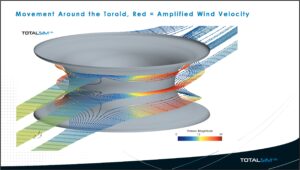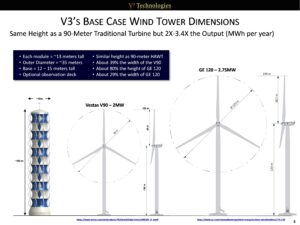Passive Fluid Amplification
There have been numerous attempts to passively amplify the velocities of wind/water to gain exponential increases in power output. For a variety of reasons, these earlier attempts demonstrated that power production could be enhanced, but those initial designs did not meet performance expectations. V3 has overcome these challenges and unlocked the benefits of amplified wind and water velocities.
Three Foundational Concepts
Wind Power Equation. The amount of electrical energy you get out of most any type of wind turbine is, in part, a cubic function of the velocity of the wind. (This is where the “V3” in V3 Technologies comes from.) This means that if you can double the ambient speed of the wind, the same turbine will produce 8X more power.
Bernoulli Effect. Basic principle from physics. One manifestation of the principle essentially states that when a fluid moves through a constricted space, pressures are created that automatically and passively increase the velocity of the fluid
The Shape of the Wind/Water. The toroidal shape of the module used by V3 forces the fluid to change its shape as it moves around the cylindrical concavity. This shape, known as a horizonal wind shear, requires the use of a different type of turbine to more fully capture the power potential of the moving fluid. (The type of turbine you use matters)
V3’s recent CFD studies for Shell proved that the updated design passively amplifies ambient wind/water by over 2X, and the unique turbines being deployed by V3 substantially increase the amount of power generated from a given turbine in the amplified wind stream
Basic Design
Note: The following description and images are illustrative and purposefully hide or obscure trade secrets of the technology. Detailed design information is available following appropriate non-disclosure agreements.
Toroidal Modules

A toroid resembles an hourglass shape, and it forces wind/water to be squeezed as it moves around the module. This leads to over a 2X passive amplification of the wind/water as well as a physical infrastructure on which to secure multiple turbines and vanes.
Vertically Stacked Toroidal Modules

The base case wind version is about the same height as a traditional 2 megawatt wind turbine, but because of the modularity the V3 tower can easily be built with fewer modules and be shorter if necessary.
Competitive Advantages – Essentially impossible for traditional turbines to copy
Highest Renewable Energy Density: 14x-25x more power per wind farm than traditional farm using 2MW 90-meter turbines
Lowest Cost Renewable: Lowest cost per MWh of any known renewable energy technology
Lower Intermittency Impact on the Grid: >50% reduction in intermittency
Easiest Delivery/Construction in Remote Locations: All parts fit into standard shipping containers
Profound Environmental Impact Improvements: Low noise, no infrasonic pulsing, virtually eliminates bird kill
Safest Work Environment: Ability to retract components into safety of the tower
Greatest Flexibility of Appearance: Can be built to various heights and use a variety of skin colors / designs
Economics
Detailed financial models and the underlying assumptions are available for analysis, but when comparing a 1,000 acre wind farm location between a base case V3 farm and a farm using traditional 90-meter 2MW turbines, V3 provides a transformational improvement in both returns and cash flows. This is primarily due to producing between 14x-25x more power per wind farm at a lower cost per kW of capacity (lower capital costs per kilowatt) and a lower cost per MWh produced (lower O&M costs per megawatt hour of production). The numbers below do not include any subsidies, carbon credits, or any other non-market benefits.
20-year V3 Levered IRR = >28%
20-year Traditional IRR = 13%
20-year cumulative after tax cash flows for V3 = $1.66 billion
20-year cumulative after tax cash flow for traditional = $55.5 million
V3: 118% increase in IRR and 2890% increase in cumulative after tax cash flows


You must be logged in to post a comment.